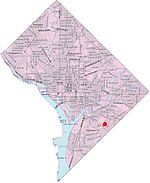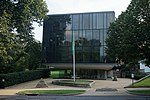British Ambassador's residence in Washington, D.C.

The British Ambassador's residence in Washington, D.C. is located at 3100 Massachusetts Avenue, Northwest, Washington, D.C. in the Embassy Row neighborhood. It was commissioned in 1925, and designed by Sir Edwin Lutyens in 1928. An example of Queen Anne architecture, the residence is the only building Lutyens designed in North America. Frederick H. Brooke, the on-site American architect, assisted with the design and oversaw the construction of the embassy, which was conducted by noted developer Harry Wardman.The home is the most prominent part of a compound that also includes the offices of the embassy chancery and is a contributing property to the Massachusetts Avenue Historic District, which is listed on the National Register of Historic Places.Prince Charles and Princess Diana stayed at the residence during their 1985 visit to Washington, D.C. Its 2009 property value is $31,308,480. There are about 10,000 visitors each year.
Excerpt from the Wikipedia article British Ambassador's residence in Washington, D.C. (License: CC BY-SA 3.0, Authors, Images).British Ambassador's residence in Washington, D.C.
Massachusetts Avenue Northwest, Washington
Geographical coordinates (GPS) Address Nearby Places Show on map
Geographical coordinates (GPS)
| Latitude | Longitude |
|---|---|
| N 38.921088888889 ° | E -77.062997222222 ° |
Address
Massachusetts Avenue Northwest
Massachusetts Avenue Northwest
20008 Washington
District of Columbia, United States
Open on Google Maps










